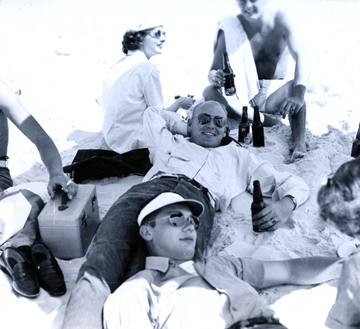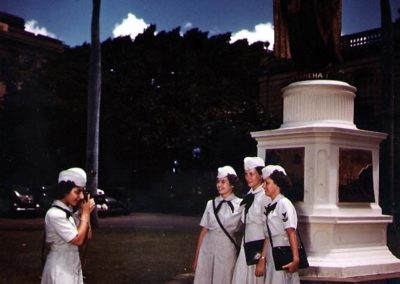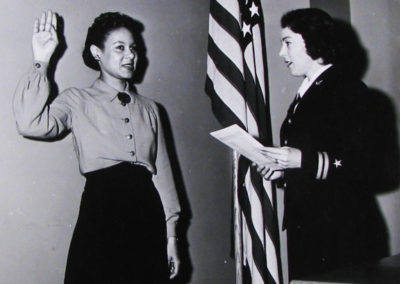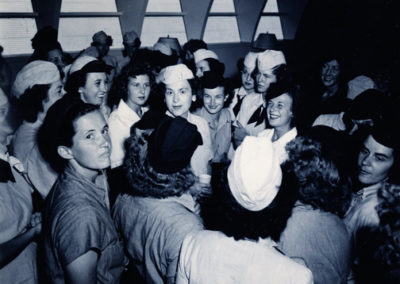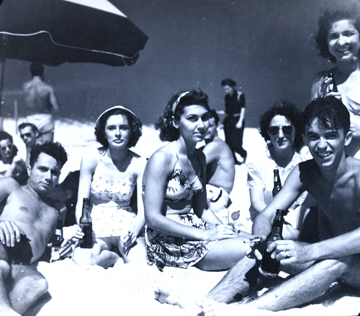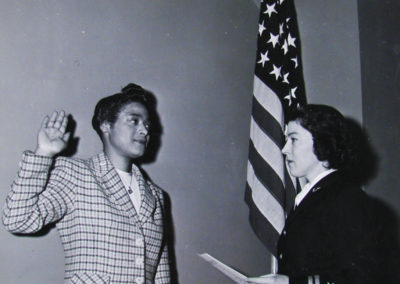Transitions
Initially, the Navy saw the WAVES as a small force of 10,000 women or less, based stateside in three specific jobs. But as the number of women within the WAVES grew, and the number of jobs diversified, the Navy’s policy towards the women changed: from opening up the WAVES to different types of women, including African-American women, to allowing the women to serve in specific overseas Naval stations.
Transitions
Minorities in the WAVES
The Navy didn’t specficially classify WAVES by race or ethnicity, so is difficult to know specifically how many non-white women enlisted. But publicity photos and other press materials indicated the Navy was interested in promoting Asian, Latinx, and Native American WAVES.
“First Ever”
I was the first-ever woman gunnery officer in the U.S. Navy. The first American-born Korean woman. Being the “first-ever” anything had its price, a blessing and a curse at the same time. Some men wanted me to fail because I was a woman: they were the ones who believed that women didn’t belong in uniform.
– Susan Ahn Cuddy, World War II Navy WAVE Officer
Latinx WAVES
Adeline Ledesma Teague, like Susan Ahn Cuddy, grew up in the Los Angeles area. And like Cuddy, she was the daughter of immigrants. Her parents were from Mexico and they worked as migrant farmworkers in Southern California. She joined the WAVES in June of 1945, and says that even though the WAVES were integrated, she still experienced some discrimination because of her heritage. Her full oral history can be read at The Betty H. Carter Women Veterans Historical Project at the University of North Carolina, Greensboro.
Native American WAVES
Delores and Belulah Beaver (above and in the photo gallery), who the Navy identifies as “full-blooded Indian WAVES,” attended a Kiowa dance ceremony while stationed in Oklahoma.
Transitions
African American WAVES
While Asian, Hispanic and Native American women were allowed into the Navy WAVES from the start, African American women were not initially invited to serve. This policy deeply offended WAVES Director Mildred McAfee, and she and others began lobbying for change.
Twisted Restrictions
African-American women were barred from serving in the Navy and Coast Guard until late 1944. This was perhaps due to a somewhat literal reading of the missive that women were “freeing a man to fight.” Since African American men worked largely in the mess hall or the laundry and were not sent to the front lines, the rationale was that African American women would not be needed to fulfill that duty.
Offensive Policy
At that stage in this outrageous situation of civil rights and wrongs, there was just no thought about admitting a black woman to replace a white man. There had been a great pressure from the black community as to why women couldn’t be in the service . . . Leaders of the negro community were just awfully hurt that in this call for service to the nation their women couldn’t be included.
– Mildred McAfee, World War II Navy WAVE Commander
Breakthrough in 1944
By war’s end, five Black women had enlisted in the Coast Guard. About 100 served in the WAVES, including two as officers, Harriet Pickens and Francis Wills. Their every move was followed by Navy photographers. The Navy has a detailed history of the negotiations and the success of Pickens and Wills as Navy officers.
Jean Byrd Stewart says she enlisted in the WAVES after seeing Pickens and Wills were officers. Listen to her oral history here.
Smile a Happy Smile
Harriet and I were asked to pose pushing down together to close a suitcase. Although the photograph itself was first-rate and has been shown many times in the years since that day it was entirely fictional. By the time that the photographer approached and described the shot he wanted, both Harriet and I had long since stowed away all our gear and were waiting with the same undisguised eagerness as all of our classmates for train time. It was not difficult to smile a happy smile.
– Francs Wills, World War II Navy WAVE Officer
Transitions
Overseas Service
When the WAVES and SPARs began, the women were limited to service in the United States. U.S. territories, including Alaska and Hawaii, were off limits. The logic was that there was no need for the WAVES or SPARs at these ports; the women taking over the shore duty so than men could go overseas. Army women, however, were allowed to serve on foreign soil.
To Hawaii and Beyond
In 1944, the Navy successfully argued to Congress that women were needed in the overseas assignments. The overseas policy changed. The vast majority of the WAVES in overseas assignments went to Hawaii, although they were also able to serve in Alaska and American territories in the Caribbean.
The first group of WAVES arrived in Hawaii in January of 1945; SPARs, like WAVES were allowed to serve in Hawaii and Alaska until the war’s end. The Navy worried about the safety of the military women: one captain suggested building a fence around the WAVES facilities to protect them from men. The WAVES were mostly yeomen and storekeepers, although radio codes and some gunnery instructors were also based there.
Getting Selected
The WAVES had strict qualification standards for women wanting to go overseas: at least six months active duty, a good conduct and work record, healthy, and “demonstrated maturity.”
The WACs were able to go overseas, and since the WAVES didn’t go on board ship, we were to relieve the guys for sea duty. Give up the desk job so they could go to sea. I guess a lot of the girls complained that they wanted to go overseas. So finally Washington did relent and said the WAVES could go overseas. As soon as they had a starting date, I immediately volunteered.
– Doris Mansfield Leichliter, World War II Navy WAVE
Shipping Out
Women traveled to the overseas ports aboard ships. Hawaii had a series of WAVES-only vessels, with just a handful of men navigating the ship to the port. The trip took a couple of weeks. One WAVE recalled that a number of WAVES on her ship got sick and so after the long cross-Pacific voyage they were held in quarantine, to make sure that everyone was healthy before disembarking.
Misconceptions
WAVE officers constantly battled a misconception in the overseas assignment. Male officers in Hawaii assumed the women would be there to act as homecoming escorts for the men returning home. Louise Wilde, who was in charge of the WAVES in Hawaii, refused to order the women to socialize:
Usually you could get them to understand that. Always when there were any ship parties, we passed the word around and if there were any volunteers who wanted to go, fine. And of course a lot of people made very good friends that way but you’re not going to order out 200 girls to march over somewhere to a party.
Transitions
Helping Men Cope
WAVES discovered they also had another, unofficial, job. By working alongside and talking with men back from the front, they could help them cope with the horrors of war.
Helping, Listening
[The Marines on the base] just got back from the battles, I don’t really know what battles. I’ve always been meaning to look up the time frame but I just haven’t. I kind of don’t want to. But they were on guard duty there, and one of them – we became friendly. I used to go down when I had time off and we’d stand and talk all the time . . . Anyway, I asked him if he had the time would he want to come home with me for Christmas. And he started to cry. He said, “I want to but I can’t. I’d ruin your Christmas.” He said, “All I can think about is the officer making me go out in the ocean and making me drag out the other Marines.” Parts of them. Not the whole body but parts of bodies so they could get the dog tags and that sort of thing. And he said, “I just can’t get it off my mind.” He said, “I stand here and I think about it all the time and it’s just awful.” And he said, ‘” know if I came home with you, I wouldn’t be any better. I might start to cry or something.” . . . I’ve often wondered how these men who got no psychological help got through the terrible horrible experience.
– Ali McLaughlin McConnell, World War II Navy WAVE
McLaughlin was a yeoman. But when telling her oral history, she emphasized that even yeomen did incredibly important work. She spent time listening to the battle-scarred Marines, helping them to get over what she called a “terrible horrible experience.” By telling her story, she is inserting into the historical record an important element of the work of World War II WAVES. They helped men to partially recover from the horrors of war.
Needing to Talk
At Hickson Field [Hawaii], there was this young man who came over. Tried to talk to me and I – I couldn’t talk to him. I was too involved in my own grief. His eyes were staring and he had bloody bandages on his head and I couldn’t talk to him and I couldn’t come out of myself and I feel awful about that. I couldn’t. They need to talk to girls from home. They were fresh from the battlefield of Okinawa . . . I did feel for them. And it kind of hit me afterward. Even as late as the last few years and this war and stuff. DAMN. I just, God, why did they have to have that? Why did they have to lose them?
– Patricia Farrington Siegner, World War II Navy WAVE
In the Hospital
I had several patients that were very — very very bad. I took care of a burn patient that you knew he was in the ward the minute you walked into the hospital almost. Oh, that poor young man. He was a pilot and he crashed — because it was an air base and he was learning to fly a corsair and he crashed. He burned. When I first saw him, he looked like a mummy except he had cut out, a big hunk cut out of his mouth here and his teeth were going. And he was getting intravenous but he also, that was were we poured fluid for him, through that cut in his mouth. And after about three or four days — the smell of a burnt person, you can’t imagine. His parents came and they sat with him. Oh, it was a sad case. I was there long enough that I saw him get up and get going again. Enough where he — they finally — his parents had brought his picture and they put it on his bedside table. And course, when he got unwrapped he didn’t look anything like the picture. He stayed on the base, because people were used to that there. Everybody said, “You’ve got to go uptown.” And he went and he came back real fast. He said, “I’m never, never going to go out in public again.” He was just a young man. 20, 21 years old. He was so scarred. I just often wondered whatever happened to him.
– Virginia Benvenuto Matich, World War II Navy WAVE
Men Coming Home
I think in a way, this is kind of off the top of my head, that the reason they had us WAVES go to Hawaii, which of course helped [in military work], was for us to mix with the fellows that were coming back from overseas. A lot of those fellows had been over there two, three years and longer. A lot of them hadn’t seen white women and they didn’t really know how to act and react to women. So it kind of, if they did come out and meet us white women to get used to us again.
– Merrily Kurtz Hewitt, World War II Navy WAVE
Kurtz shared photographs of her in Hawaii like the one above, which seemed to show her in a WWII-era version of Beach Blanket Bingo. But if you look at the photo closer, you see that she seems to be almost protecting herself, and the Marine she is with likewise seems awkward, not knowing what to do with his hands. To read more on this topic, please see Kathleen M. Ryan’s essay in Oral History and Photography, edited by Alexander Freund and Alistair Thomas.
